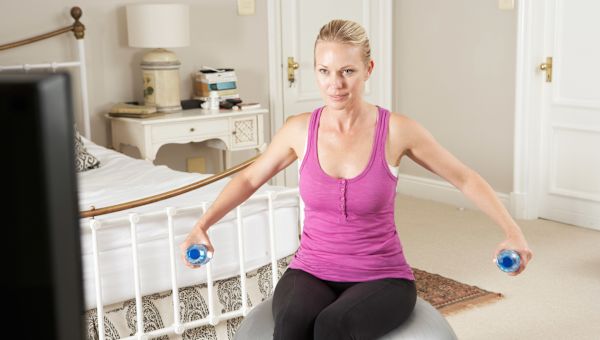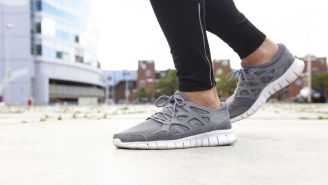The top reason to track your steps—plus, ways to take more
Keep tabs on your walking, meet your daily step goal, and get healthier.
Updated on September 26, 2025

If you’re like many people, chances are you’re not getting enough physical activity. Adults should get at least 150 minutes of moderate-intensity activity each week, or at least 75 minutes of vigorous activity, according to government experts. These same guidelines also call for muscle-strengthening activities at least twice per week. Keep in mind, if you can come closer to 300 minutes per week of moderate exercise or 150 minutes of more strenuous activity, it’s even better. In fact, the more exercise you get, the greater the health benefits.
But only about one in four adults in the United States meet these standards, the Center for Disease Control and Prevention (CDC) reports. Adults who are inactive put themselves at higher risk for various chronic health issues, including diabetes, heart disease, cancer, dementia, and depression.
If these recommendations seem challenging, remember that any amount of physical activity is better than none. Just try to move more and sit less, experts advise. Exercise also doesn’t have to involve a gym or heavy equipment, such as a treadmill. Shoveling, gardening, taking your dog for a walk, and other low-impact activities are all considered exercise. Even just a two-minute stroll offers health benefits and will count toward your weekly fitness goals.
Meanwhile, here are some ways you can add some extra steps into your day.

Track your steps
Tracking your steps can help you meet daily fitness goals, and research suggests that using a pedometer, a wearable step tracker, or your smartphone can help you be more active. Smartphone apps may be particularly effective tools for driving activity, according to a 2021 review of 35 studies published in the British Journal of Sports Medicine. Apps that use an accelerometer, which automatically track how much you move, may work best since they’re largely effortless.
If you own a smartphone—more than 9 in 10 U.S. adults do—you can easily track your steps. The step tracker in Sharecare, available for iOS and Android, can record every step you take throughout the day once automatic tracking is enabled. You can also enter your steps manually.

Take the stairs
Need to go up or down a floor for an office meeting? Take the stairs instead of the elevator. Small, vigorous movements spanning one or two minutes—like climbing the stairs—are linked to substantially lower mortality, according to a 2022 study published in Nature Medicine.

Exercise while watching TV
As you watch your favorite show, march in place, do some jumping jacks, or try a plank to raise your heart rate. By finding ways to stay active during the day, you exercise your muscles and reduce your risk of heart disease.

Walk to work and on your lunch break
If you live near the office or the train station, a great way to add steps to your day is to walk instead of driving. You can also get off public transit a stop or two early and walk the rest of the way to your workplace. On sunnier days, venturing outside during your lunch break will help soak up some vitamin D and its much-needed benefits. Exercise of any sort—such as a brisk walk to work—helps to reduce stress and anxiety.

Walk to a coworker’s desk
Instead of reaching out to a colleague via messaging, email, or phone call, take a walk to their desk to ask for help. Not only will you sneak in a few extra steps, it’s easier to get their attention. You can also take your meetings on the move. Snag your coworker for a walk-and-talk instead of sitting in a conference room.

Pace on the phone
Whether it’s on the job, in the comfort of your own home, or on the go, taking a stroll while talking on the phone helps fit some additional steps into your day. Plus, it can get circulation going and help avoid blood clots, especially if you’ve been sitting for a few hours.

Park far away
By parking your car further away from the entrance of a building, or on the top floor of a parking garage, you can add extra steps to get to and from where you’re going.
Bonus: Climbing parking garage stairs burns about 60 percent more calories as walking at a moderate pace. Just be careful at night or in dimly lit areas.

Clean the house
Picking up around the house for a few minutes before bed is another productive way to pack steps into your day. According to some research, it can even help mitigate the negative impact on your well-being that messy living environments can sometimes bring.
During the day, run the vacuum, or mop the floor to clean your house while getting in additional steps.

Get others involved
One of the best ways to stick to a walking plan is to get friends and family moving with you. Gather your loved ones and go for an after-dinner stroll. Commit to lunch time walks with a coworker. Instead of happy hour, meet a friend to catch up in a local park. Have them track their steps, as well. A little friendly competition might motivate everyone to move more.

U.S. Department of Health and Human Services. Physical Activity Guidelines for Americans 2nd Edition. December 2020.
Elgaddal N, Kramarow EA, Reuben C. Physical Activity Among Adults Aged 18 and Over: United States, 2020. NCHS Data Brief. 2022 Aug;(443):1-8.
Centers for Disease Control and Prevention. Physical Activity Basics: Benefits of Physical Activity. April 24, 2024.
Laranjo L, Ding D, et al. Do smartphone applications and activity trackers increase physical activity in adults? Systematic review, meta-analysis and metaregression. British Journal of Sports Medicine. 2020;55(8):bjsports-2020-102892.
Ferguson T, Olds T, et al. Effectiveness of wearable activity trackers to increase physical activity and improve health: a systematic review of systematic reviews and meta-analyses. Lancet Digit Health. 2022 Aug;4(8):e615-e626.
Pew Research Center. Mobile Fact Sheet. November 13, 2024.
Stamatakis E, Ahmadi MN, et al. Association of wearable device-measured vigorous intermittent lifestyle physical activity with mortality. Nature Medicine. 2022;28(12):2521-2529.
National Heart, Lung, and Blood Institute. Physical Activity and Your Heart: Benefits. March 24, 2022.
NIH Office of Dietary Supplements. Vitamin D: Fact Sheet for Health Professionals. June 27, 2025.
Office of Disease Prevention and Health Promotion. Manage Stress: Take Action. March 5, 2025.
Kotz CM, Perez-Leighton CE, , et al. Spontaneous Physical Activity Defends Against Obesity. Current Obesity Reports. 2017;6(4):362-370.
Centers for Disease Control and Prevention. Venous Thromboembolism (Blood Clots). May 15, 2024.
American Council on Exercise. ACE Fit | Physical Activity Calorie Counter. Accessed on February 9, 2023.
Roster CA, Ferrari JR, Peter Jurkat M. The dark side of home: Assessing possession “clutter” on subjective well-being. Journal of Environmental Psychology. 2016;46:32-41.
More On


video

article

slideshow


video


video
